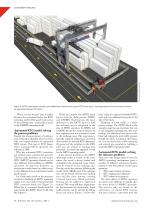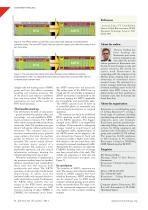 Website:
Konecranes
Website:
Konecranes
Catalog excerpts

Container Handling The case for automated RTG container handling Thomas Gylling, head of port cranes process automation, Konecranes, Hyvinkää, Finland RTG operating model gains ground Picture courtesy of Konecranes 2013 The ARMG and CARMG operating models have gained ground, but not at the expense of the rubber-tyred gantry (RTG) operating model, which has grown as well. The RTG operating model can offer important advantages for greenfield terminals, brownfield terminals and terminals undergoing conversion. The RTG operating model is suitable for container terminals with land use restricted by the surrounding environment e.g. por ts loc ated in densely-built urban areas. The RTG operating model is especially suitable for terminals, now using reach stackers or straddle carriers, which want to move to a higher-density stacking operation for higher productivity. The RTG operating model is very adaptable and flexible. It can also achieve a container stacking density approaching that of its ‘stiffer big brothers’, the ARMG and CARMG. See Figure 3 for a typical RTG container block. Picture courtesy of Konecranes 2013 Figure 1: ARMG block layout based on typical ARMG operating model. Picture courtesy of Konecranes 2013 Figure 2: CARMG container block layout, based on typical CARMG operation. Figure 3: RTG container block layout based on typical RTG operation. Picture courtesy of Konecranes 2013 Automated container handling is a recognised megatrend in the container hand ling industr y. It star ted bac k in the early 1990s, when the ECT Delta Terminal, Rotterdam, began to use unmanned rail mounted gantr y cranes in their container yard, with considerable success. The industr y noticed, and investment in new automated terminals grew. Automated container handling technology developed quickly, concentrating on the cranes handling the intermediate storage of containers in the yard. The automated rail-mounted gantry (ARMG) crane was popular from the beginning for greenfield terminals where it was advantageous to build container blocks perpendicular to the quay, with exchange areas at the block ends. This is often called an ‘end-loading’ operation. A popular endloading design uses two identical ARMG cranes in each container block, running on the same rail with the main operating areas (see Figure 1). A f t e r t h e E C T D e l t a Te r m i n a l successfully pioneered the first ARMG yard, automated RMG operating models where taken into use at Thamesport in the UK, at Container Terminal Altenwerder in Germany, at Ohi Terminal in Japan, and at Evergreen in Taiwan. The ARMG operating model and technology were field-proven. An alternative ARMG operating concept was also developed, in which the exchange areas were moved from the block-ends to the block sides, along the full length of the block. Because the cranes need to reach over the truck lanes, larger rail-mounted gantry cranes with cantilevers (CARMG) are used for such ‘side-loading’ blocks. CARMG blocks are built parallel to the quay. This provides a typical CARMG container block layout (see Figure 2), which has been selected in locations with higher transshipment cargo flows. Figure 4: ARTG block layout, based on typical manned RTG operation.
Open the catalog to page 1
Picture courtesy of Konecranes 2013 Container Handling Figure 5: ARTG block layout example, brownfield layout derived from typical RTG block layout. Exchange area of one truck lane and truck by-pass lane between the blocks When a truck ‘by-pass’ lane is added between the container blocks, the RTG operating model offers good truck access to the exchange area - practically as good as the CARMG operating model. Automated RTG model: solving the process problems Despite the strong evolution of container yard automation globally, there has been only one implementation of unmanned RTG cranes. This...
Open the catalog to page 2
Picture courtesy of Konecranes 2013 Container Handling References Laurence Jones, T T Club/ICHCA Director Global Risk assessment, PEMA Equipment Technology Forum at TOC Europe 2013 i Picture courtesy of Konecranes 2013 Figure 6: The ARTG system can be built up per block while retaining conventional RTG operation blocks. The new ARTG block here can cater for higher truck traffic flow thanks to the two truck lanes. Figure 7: The converted new ARTG block here is similar to the CARMG and existing implementation which can separate the land side and water side horizontal traffic with the...
Open the catalog to page 3All Konecranes catalogs and brochures
-
AUTOMATED CONTAINER HANDLING
4 Pages
-
RTG RETROFITS
28 Pages
-
BIG IN BRAZIL
2 Pages
-
YOUR WAVE OF SUCCESS
11 Pages
-
RIGHT ON TRACK
11 Pages
-
Ship-to-Shore gantry crane
2 Pages
-
Straddle carrier
22 Pages
-
Konecranes ARTG brochure
12 Pages
-
RailQ Runway Survey
4 Pages
-
RopeQ inspection brochure
2 Pages
-
Rubber Tired Gantry Crane
2 Pages
-
Smarter CXT Cranes
8 Pages
-
Space-Saving Industrial Cranes
13 Pages
-
Steel industry offering
20 Pages
-
Steel Melt Shop Cranes
12 Pages
-
Stepless Speed Chain Hoists
2 Pages
-
Sway Control
4 Pages
-
The Crane With a Brain - SMARTON
32 Pages
-
TRUCONNECT Remote Monitoring
4 Pages
-
XM Light Crane Systems
4 Pages
-
Shipyard Cranes
16 Pages
-
Power options for RTGs
7 Pages
-
Paper Roll Vacuum Lifter
2 Pages
-
Port Crane Inspections
6 Pages
-
Nuclear Dry Cask Transporter
3 Pages
-
Munckloader Cranes
8 Pages
-
Hevi-Lift Hoists
3 Pages
-
Compact Conductor Systems
3 Pages
-
CXT Biomass Crane
12 Pages
-
CXT Compact
6 Pages
-
Goliath Gantry Cranes
2 Pages
-
DynA Vector II
12 Pages
-
Automated RTG
12 Pages
-
Fuel Saving products for RTG
3 Pages
-
RTG
2 Pages
-
RMG
4 Pages
-
Shipyard crane
6 Pages
-
AGD
6 Pages
-
Box runner
20 Pages
-
STS
2 Pages
Archived catalogs
-
CONTAINER LIFT TRUCKS
12 Pages
-
REACH STACKER
12 Pages
-
KONECRANES
8 Pages









































































